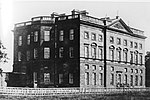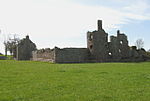Barnes Castle
16th-century establishments in ScotlandCastles in East LothianScheduled Ancient Monuments in East LothianUnfinished castles

Barnes Castle is an unfinished castle, with a number of defensive banks, located 5 kilometres (3.1 mi) north-east of Haddington in East Lothian, Scotland. It is close to Athelstaneford on the slopes of the Garleton Hills. The remains, also known as Barney Vaults or The Vaults, are protected as a scheduled monument.
Excerpt from the Wikipedia article Barnes Castle (License: CC BY-SA 3.0, Authors, Images).Barnes Castle
B1343,
Geographical coordinates (GPS) Address External links Nearby Places Show on map
Geographical coordinates (GPS)
| Latitude | Longitude |
|---|---|
| N 55.979714 ° | E -2.756959 ° |
Address
Barnes Castle (The Vaults)
B1343
EH39 5BB
Scotland, United Kingdom
Open on Google Maps








